- Comics
- Comics Reviews
- Manga
- Comics Reviews
- European Comics
- News
- Comics News
- Press Releases
- Columns
- Spotlight
- Digital Comics
- Webcomics
- Cult Favorite
- Back Issues
- Webcomics
- Movies
- Toys
- Store
- More
- About
By Eli Green
September 12, 2006 - 00:00
The
story of Max Payne 2 takes place not too long after the end of the
first game. Max has switched back to the NYPD after killing the
person responsible for his family's murder, but while at the scene of
a murder investigation he runs into Mona Sax, a woman he assumed was
killed. He soon finds out there is a hit out on his life, and in
trying to stop it, he ends up in a downward spiral and his partner,
Detective Winterson, ends up dead.
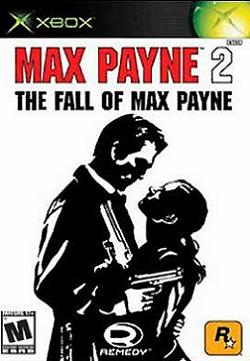
It's probable that one of the best things, just when you put the disc in to play the game, is that you don't need to have played the first game or know the original story to play Max Payne 2, because the game comes with a recap of the original story. Even if you don't watch the recap, you can play Max Payne 2 because it's a story unto itself, though you might not get some of the side references. I actually recommend playing the original game, just on the basis of it being a great game, but it isn't completely necessary.
The prologue of the game begins in the middle of the story, with Max in a hospital, after he nearly died from bullet wounds. He wanders around trying to find his way out. As he is about to step out of the elevator on the main floor, he meets Chief Jim Bravura, who begins to chew him out about the Winterson's death, but is shot by one of the men trying to kill Max. While shooting, the killer accidentally hits an oxygen tank, which explodes and causes the elevator to drop to the bottom floor. Max ends up in the morgue, finds Winterson's body and the scene flashes back to the beginning of the story and how he ended up in the hospital.
Gameplay
Most
people who played the original Max Payne should already be familiar
with the control and bullet time systems, minus the addition of the
bullet time combo move (Max ducks and spins around) on the PC version
and a slight change to the bullet time system itself (bullet time is
slightly faster and diving no longer lowers the bullet time meter).
For people who haven't played the original game, though, the control
system is very easy to learn and shouldn't be any problem to master.
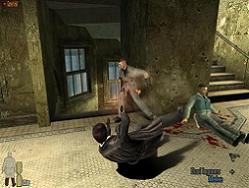
I have played, both, the demo of the PC version and the full Xbox version of the game and the only difference I noted was the lack of the bullet time combo, which I didn't really miss. The PC setup is the regular keyboard and mouse control system. The Xbox setup uses every button on the controller, including the control stick buttons, which is probably why the bullet time combo was left out. There wasn't a button for it. The setup for aiming in the Xbox was very smartly done. Normally, quick, precise aiming in shooters on consoles is a problem, because the control sticks only allow for a limited movement speed. If the control stick is too sensitive, the aiming is too quick and can get ahead of a player, and if it's not sensitive enough, aiming and turning are too slow and a player might get killed before he/she have the chance to turn around. What Remedy did to fix that, was use the button on the control stick used for aiming as a “quick aim” button. When the button is pressed when aiming, Max aims and turns quicker, and when it's not pressed, Max aims and turns at his regular pace. This allows for quick or slow precise aiming when one or the other is necessary.
Max's
pain and bullet time meters are still replenished in the same way as
in the original game. Painkillers relieve the pain, and killing
enemies boosts the bullet time meter. There is one other addition to
the control system that was a very nice touch. When Max dives while
shooting, he can still shoot while lying on the floor, before
standing up, allowing him to finish off enemies and avoid being shot
while getting off the floor.
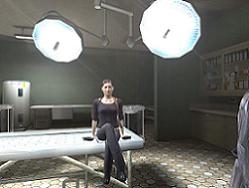
The games also includes some puzzles, which can change the way you get through the game. Deciding to use certain objects or not can change certain obstacles in your way or what lies ahead. There were also more dream levels this time round, and they were considerably different from the ones in the first game. The fact that Max can't actually die in the dreams made them noticeably more dreamlike than the dream levels in the original game, in which he was able to die, even though it was just a dream.
Two other aspects which enhanced the gameplay were the continuation of use of everyday objects to add to the environment, which I'll explain in a second, and the ability to team up with characters along the way, which wasn't available in the first game. What I meant by “use of everyday objects to add to the environment” was that in the original game, TVs, radios and some other objects were actually usable to the point that there are actual shows and commercials they made for the game. Things like the show “Address Unknown” or the comic “Captain Baseball Bat Boy”, which were used in the original game, are used in Max Payne 2, but are even more prevalent than in the original game, a very nice touch.
Environment and Graphics
The
environments and the characters looked essentially the same as in the
first game, with some touch ups, still making an attempt at
photorealism, but doing a better job at it. Things like explosions
and fires looked considerably nicer, but the most noticeable
improvement in the graphics were the characters when viewed close up.
Their facial movements when speaking looked more natural, and their
faces looked more animated, compared to the look of Max's squinty
face versus his non-squinty face in the original game. I was actually
slightly disappointed by the fact that they couldn't make the
graphics a little better, but considering the fact that the game
wasn't released that long after the original, they did a good job.
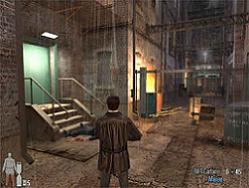
There were more things to interact with in the environments, which was a nice touch. What would have been even more amazing is if they had made the TV shows fully animated instead of simply using flashing pictures with the sound, but considering the amount of time you're able to watch the TV shows, listen to recordings, phone messages or many other things, you can see that they still put a lot of time and effort into those things.
All
the cutscenes are real time, just like in the original game, which is
particularly nice because they mesh right into the gameplay. Remedy
kept the use of the “last man dead” cinematic (when you kill the
last enemy in a room, it shows how he dies) and the sniper bullet
camera (which follows the path of the bullet as it flies), but they
also added a nice little extra with special kills. Now if you kill
certain characters in the right places, their death will show
a
special cinematic, but since it's in real time, the way they die can
change or be slightly different each time. For instance, if you shoot
someone and he falls out of a window on to an object, the object will
react in different ways, or the body will land differently each time.
They were able to do this with the use of real time cinematics and
good rag doll physics.
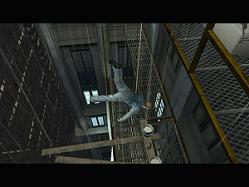
A lot of the story is still told through the graphic novel panels, which was one of the things that made the original game so unique. The image detail is pretty much the same, though I wouldn't have expected their to be any way to improve that. The layout of each panel was done differently, however, and is more stylized which added a bit to the overall look.
Sound
Everything
sounded right. That's the stance I'm taking and I don't have a reason
not to, because it did. Everything just sounded like it belonged
where it was. The theme music from the original game was used again,
which was great, and the sounds of guns firing to bullets hitting
people or objects sounded in place. The bullet time noise was still
used, and so was the painkiller sound, whenever Max or other
characters used them, or any other kind of pill.
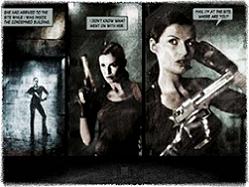
The voice acting was great, as it was in the first game. Max's voice still has that same scratchy sound to it, though I still wish he could increase his tone range from time to time, and other voices, like Vinnie Gognitti and Alfred Woden, stayed the same. The only voice that sounded a little different from the first game was Vladimir's, and the accent was still done well. The actors did very well in conveying character emotions and attitudes, in particular, Max's generally depressed tone, Vinnie's high pitched scaredy-cat whine and Vladimir's cocky, man of the world air.
Unfortunately, since our Xbox is not hooked up to a surround sound system, I can't tell you how the game sounds in full surround. For people whose want to play the game in surround, though, you'll be happy to know that the game uses full Dolby Digital, so at least you can enjoy it. Maybe one day we'll move the Xbox into the living room.
Conclusion
Max Payne 2: The Fall Of Max Payne is an action packed game with a great story and a lead character a load of attitude. People who played the original Max Payne will find Max Payne 2 easy to pick up and play, and they should enjoy it as much as the original, maybe more. And while it's not necessary to play the original game before this one, I do recommend it, for the extra side references that come up in the game.
Environment and Graphics: 8.8
Sound: 9
Story: 9.5
Fun: 9
Verdict: Buy It